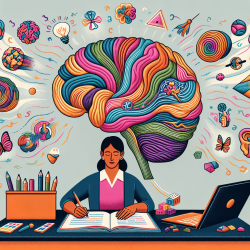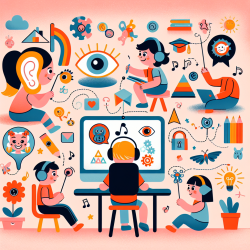Understanding Age-Related Sensory Memory Declines: Implications for Practitioners
In the field of speech-language pathology, understanding the nuances of sensory memory and its decline with age is crucial for developing effective therapeutic strategies. The research article "Age-Related Declines in Early Sensory Memory: Identification of Rapid Auditory and Visual Stimulus Sequences" offers valuable insights into how age affects sensory memory, particularly in processing rapid auditory and visual sequences. This knowledge can significantly enhance a practitioner's ability to tailor interventions for older adults experiencing sensory processing difficulties.
Key Findings from the Research
The study conducted by Fogerty, Humes, and Busey (2016) examined how sensory memory declines with age, focusing on the ability to recall rapidly presented auditory (vowel) and visual (letter) sequences. The researchers found that:
- Older adults exhibited poorer performance in recalling the order of auditory sequences compared to younger adults, particularly for final items in a sequence.
- While younger adults showed a strong recency effect in auditory tasks, older adults did not, suggesting a decline in the sensory memory store for recent items.
- In visual tasks, older adults performed similarly to younger adults when sequences were equated for temporal processing differences, but still showed a decline in recalling later items in longer sequences.
These findings highlight the modality-specific processing declines in older adults and suggest an additional amodal processing decline related to early sensory memory, particularly affecting the recall of final items in a sequence.
Implications for Practice
For practitioners, these insights can inform the development of targeted interventions that consider the sensory memory limitations of older adults. Here are some practical applications:
- Tailored Auditory Training: Incorporate exercises that focus on improving the recall of auditory sequences, especially targeting the final items in a sequence. This could involve gradually increasing the complexity and speed of auditory tasks to enhance sensory memory retention.
- Visual Sequence Exercises: Design visual tasks that help older adults improve their recall of sequences, focusing on strategies to strengthen memory for later items. This might include using visual aids or mnemonic devices.
- Multimodal Approaches: Since the study suggests an amodal processing decline, integrating both auditory and visual exercises could provide a more comprehensive approach to improving sensory memory.
By understanding the specific sensory memory challenges faced by older adults, practitioners can better support their clients in maintaining cognitive function and improving communication skills.
Encouraging Further Research
While this study provides significant insights, it also opens avenues for further research. Practitioners are encouraged to explore additional studies that investigate the interplay between sensory and cognitive declines in aging. Understanding the underlying mechanisms can lead to more effective interventions and improved outcomes for older adults.
To read the original research paper, please follow this link: Age-Related Declines in Early Sensory Memory: Identification of Rapid Auditory and Visual Stimulus Sequences.










